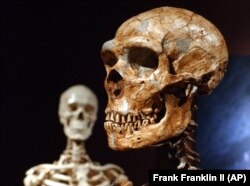The human species, Homo sapiens, developed about 300,000 years ago in Africa. The oldest-known Homo sapien fossils were discovered at a place in Morocco called Jebel Irhoud, between Marrakech and the Atlantic coast.
But very few fossils remain from that time. The fossils that do remain come from areas very far apart from one another. Some of them were discovered in Ethiopia, while others were found in South Africa.
That makes it difficult for scientists to know how our species developed and spread across the African continent.
But a new study using genome data from modern-day African populations may help explain that development and spread.
The study suggests that many ancestral groups moved across geographic areas and mixed with each other over hundreds of thousands of years. It also found that everyone alive today can connect their ancestry to at least two different populations that were present in Africa about a million years.
These results differ from an earlier explanation about our species. That idea suggested Homo sapiens developed in only a single area or mixed with a related species.
"All humans share relatively recent common ancestry, but the story in the deeper past is more complicated than our species evolving in just a single location or in isolation," said Aaron Ragsdale. He is a population geneticist at the University of Wisconsin-Madison. He was the lead writer of the study, which appeared recently in the publication Nature.
Because early groups moved and mixed, isolated groups did not develop. When groups are isolated, they are more likely to become genetically different from other groups. But the movement and mixing across Africa kept the groups’ genetic material similar.
Scientists looked at genome data from 290 modern-day people, mostly from four populations from different areas in Africa. The four groups were also genetically diverse. The scientists could then connect both similarities and differences among these four groups to genetic connections dating back hundreds of thousands of years.
The groups included the following: 85 individuals from a West African group called the Mende from Sierra Leone; 44 individuals from the Nama Khoe-San group from southern Africa; 46 individuals from the Amhara and Oromo groups in Ethiopia; and 23 individuals from the Gumuz group, also from Ethiopia.
The scientists also included 91 Europeans. This was to measure the possible effect of European and Neanderthal ancestry on the genome. Neanderthals are an extinct human species and were found mostly in Europe until about 40,000 years ago.
Scientists say they have not yet found ancient DNA from the few fossils dating to the time around 300,000 years ago. However, the genome data from modern populations can help them form a picture of how Homo sapiens developed.
Study co-writer Simon Gravel is a geneticist at McGill University in Montreal, Canada. He said, “The relatedness among contemporary humans contains a lot of information about this chain of events.”
I'm Andrew Smith.
Will Dunham wrote this story for Reuters. Andrew Smith adapted it for VOA Learning English.
_____________________________________________________________________
Words in This Story
fossil -n. the hard remains of a prehistoric animal or plant that are found inside a rock.
geographic -adj. relating to large areas of land
complicated -adj. having complexity; not simple
evolve -v. to develop over time
location -n. a place
isolate -v. to make or keep separate from other things or groups
contemporary -adj. relating to things happening now
______________________________________________________________________
We want to hear from you.
We have a new comment system. Here is how it works:
- Write your comment in the box.
- Under the box, you can see four images for social media accounts. They are for Disqus, Facebook, Twitter and Google.
- Click on one image and a box appears. Enter the login for your social media account. Or you may create one on the Disqus system. It is the blue circle with “D” on it. It is free.
Each time you return to comment on the Learning English site, you can use your account and see your comments and replies to them. Our comment policy is here.


Forum